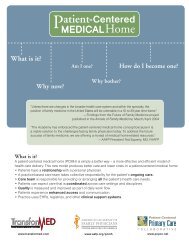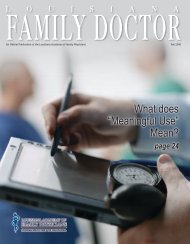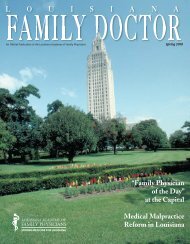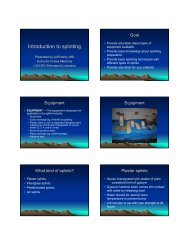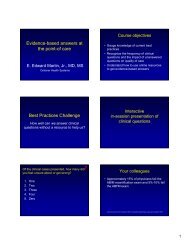New Drug Update 2009-2010 - LAFP
New Drug Update 2009-2010 - LAFP
New Drug Update 2009-2010 - LAFP
You also want an ePaper? Increase the reach of your titles
YUMPU automatically turns print PDFs into web optimized ePapers that Google loves.
This new safety information, originally announced in August <strong>2009</strong>, is based on FDA's completed review<br />
that identified 13 total reports of severe liver injury with orlistat; 12 foreign reports with Xenical and 1 U.S.<br />
report with Alli.<br />
December 3, <strong>2009</strong> FDA Alert Risk of Neural Tube Birth Defects following prenatal exposure to<br />
Valproate The FDA is reminding health care professionals about the increased risk of neural tube defects<br />
and other major birth defects, such as craniofacial defects and cardiovascular malformations, in babies<br />
exposed to valproate sodiumand related products (valproic acid and divalproex sodium) during<br />
pregnancy. Healthcare practitioners should inform women of childbearing potential about these risks, and<br />
consider alternative therapies, especially if using valproate to treat migraines or other conditions not<br />
usually considered life-threatening.<br />
Women of childbearing potential should only use valproate if it is essential to manage their medical<br />
condition. Those who are not actively planning a pregnancy should use effective contraception, as birth<br />
defect risks are particularly high during the first trimester, before many women know they are pregnant.<br />
FDA has required a patient Medication Guide for each antiepileptic drug (AED), including valproate.<br />
Valproate sodium is marketed as Depacon. Dilvalproex sodium is marketed as Depakote, Depakote CP,<br />
Depakote ER. Valproic acid is marketed as Depakene and as Stavzor.<br />
Pregnant women using valproate or other AEDs should be encouraged to enroll in the North American<br />
Antiepileptic <strong>Drug</strong> (NAAED) Pregnancy Registry (1-888-233-2334; www.aedpregnancyregistry.org).<br />
January 29, <strong>2010</strong> FDA Alert Zyprexa (olanzapine): Use in Adolescents Lilly and FDA notified<br />
healthcare professionals of changes to the Prescribing Information for Zyprexa related to its indication for<br />
use in adolescents (ages 13-17) for treatment of schizophrenia and bipolar I disorder [manic or mixed<br />
episodes]. The revised labeling states that:<br />
Indications and Usage: When deciding among the alternative treatments available for adolescents,<br />
clinicians should consider the increased potential (in adolescents as compared with adults) for weight<br />
gain and hyperlipidemia. Clinicians should consider the potential long-term risks when prescribing to<br />
adolescents, and in many cases this may lead them to consider prescribing other drugs first in<br />
adolescents. (Effectiveness and safety of ZYPREXA have not been established in pediatric patients less<br />
than 13 years of age).<br />
February 16, <strong>2010</strong> FDA <strong>Drug</strong> Safety Communication Erythropoiesis-Stimulating Agents (ESAs):<br />
Procrit, Epogen and Aranesp: FDA and Amgen notified healthcare professionals and patients that all<br />
ESAs must be used under a REMS risk management program. As part of the risk management program,<br />
a Medication Guide explaining the risks and benefits of ESAs must be provided to all patients receiving<br />
an ESA. Under the ESA APPRISE Oncology program (Assisting Providers and Cancer Patients with Risk<br />
Information for the Safe use of ESAs), Amgen will ensure that only those hospitals and healthcare<br />
professionals who have enrolled and completed training in the program will prescribe and dispense ESAs<br />
to patients with cancer. Amgen is also required to oversee and monitor the program to ensure that<br />
hospitals and healthcare professionals are fully compliant with all aspects of the program. FDA is<br />
requiring a REMS because studies show that ESAs can increase the risk of tumor growth and shorten<br />
survival in patients with cancer who use these products. Studies also show that ESAs can increase the<br />
risk of heart attack, heart failure, stroke or blood clots in patients who use these drugs for other conditions<br />
such as Chronic Renal Failure: Box Warning: In clinical studies, patients experienced greater risks for<br />
death, serious cardiovascular events, and stroke when administered erythropoiesis-stimulating agents<br />
(ESAs) to target hemoglobin levels of 13 g/dL and above. Individualize dosing to achieve and maintain<br />
hemoglobin levels within the range of 10 to 12 g/dL.<br />
February 17, <strong>2010</strong> FDA <strong>Drug</strong> Safety Communication: Product Confusion with Maalox Total Relief<br />
and Maalox Liquid Products<br />
The FDA has received five reports of serious medication errors involving consumers who used Maalox<br />
Total Relief, the upset stomach reliever and anti-diarrheal medication, by mistake, when they had<br />
intended to use one of the traditional Maalox liquid antacid products.<br />
Due to the potential for serious adverse events from product confusion, the maker of Maalox brand<br />
products has agreed to:<br />
10




